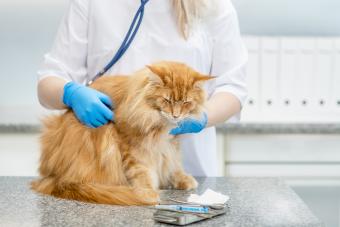
Chances are, if you're wondering about cat fleas on humans, you've noticed a few small bright red spots running up and down your arms or legs. Cat fleas can definitely bite humans, and this is especially common if you have a flea infestation in your home, whether you're aware of it or not. Find out which steps to take to treat the fleas and eliminate them from your home, letting both you and your kitty get a little itch-free peace.
Can a Human Catch Fleas From a Cat?
If there's a pet in your home with fleas, these little blood-suckers can easily jump from them onto you for a snack. Yes, jump. Fleas don't fly, but they can jump as far as 19 inches! Adult fleas will jump off of a cat's body onto your furniture, carpets, bedding, and your pet's bed as well.
Luckily, cat fleas can't live on humans for long, so they need a different, furry animal as a host. Therefore, if you pet a kitty with fleas and one bites you, it can't make itself at home unless you bring it to a pet in your home who doesn't have flea preventative.
It's not just outdoor cats who have and bring in fleas. Indoor kitties can get them from dogs in the house, wild rodents, infested items you bring into the home, or even window cracks.
Do Cat Fleas Bite Humans?
Fleas survive by drinking the blood of their host, whether it's a cat, dog, wild animal, or human. Even though humans aren't ideal hosts, when a flea lands on you and comes into contact with your skin, it's a natural response for them to bite down. But the good news is, they won't hang out for long.
Can Cat Fleas Live on Human?
No, fleas don't live on humans. They need specific conditions to reproduce and only lay their eggs in pet fur or bedding where the baby fleas can develop. Studies show that female fleas will hang out on humans for an average of 7.4 mintues, and male fleas for 4.4 minutes. That's not very long.

Recognizing Cat Flea Bites
If you've been bitten by fleas from your cat, you might see these symptoms:
- Small, red bumps on your skin, usually clustered in groups of 3 or 4
- Swollen, red areas (a "halo") around the bumps caused by an allergic reaction
- Itchy skin on and around the bumps
- Bites can occur anywhere but are most often found on the ankles, legs, back of the knees, groin, waist, armpits, and under the breasts/
Although it's very rare, fleas can lead to more serious conditions for people, including tapeworms, typhus, and bubonic plague.
Trouble for People With Flea Bite Allergies

Cat flea bites aren't just troublesome for humans who have insect bite allergies. In these cases, the tiny red spots caused by fleas exacerbate into large red mounds that may even become infected.
Symptoms of people with allergic reactions to flea bites include:
- Extreme itchiness around the red areas on your skin
- Rash
- Hives
- Respiratory problems, including wheezing, shortness of breath, and general difficulty breathing
- Breathing problems may worsen to include chest pain
- Swelling in other areas of the body, particularly the tongue, lips, and face
- Nausea and dizziness
- Skin infections, which usually result from excessive scratching
It's Common Not to See Fleas
It's not uncommon to see signs of flea bites on you or your pets without seeing a single flea on them. Only 5% of the fleas that attack your arms and legs are present on your cat. Instead, your carpet, rugs, furniture, and even bedding are the real culprits housing the remaining fleas. This includes adult fleas as well as eggs, larvae, and pupae.
As if the very idea of such a flea population isn't disturbing enough, fleas defecate as well. Flea poop looks like tiny black dots or grains of sand, and you will find this "dirt" everywhere if you don't meet your flea infestation head-on.
Cat Fleas & Dogs
Fun fact: the flea most commonly found on dogs is actually the cat flea. "Dog fleas" are only responsible for about 5% of flea cases on dogs, so the cat flea is a pest both cat and dog owners need to be aware of. That said, to a human with fleas in the house, a flea is a flea is a flea, and getting rid of them is the same for both types of flea.
Cat fleas make their way onto dogs in the same way they do humans. If the fleas on the cat are jumping off onto the carpet and furniture, they're sure to get onto your dogs as well. Likewise, dogs can give cats in your home cat fleas.
Related: How to Identify and Treat Flea Bites on Humans & Dogs
Getting Rid of Fleas on Cats
There are various approaches to battling a flea problem, but pet owners should be aware that the real flea problem isn't actually located on your cat. Of course, you'll want to treat your kitty to make sure no fleas hitch a ride on them after being vacated from your home, but you'll also need to treat yourself and your environment as well.
Get Fleas Off Your Cat
Start by treating your cat with a flea preventive medication. You can find both oral and topical treatments, but make sure you only use one that's designed specifically for cats. Some, like Capstar, can start working in as quickly as 30 minutes, whereas others might need 24 hours to take full effect. Ask your veterinarian for the best option and find out if you need a prescription for the med.

Cats with big flea infestations might need a bath to help wash some of the fleas and flea dirt away. Make sure to read the directions on your flea preventive because some, like Frontline, shouldn't be applied within a few days of a bath.
Along with your cat, you'll need to treat all other pets in your home. Otherwise, the fleas will just jump from one pet to the others. Some flea treatments for dogs that you apply to the skin contain an ingredient that's toxic to cats, so it's safest to separate the treated dogs and cats for at least 72 hours after application.
Related: Choosing Flea, Tick and Heartworm Pills or Medicine
Get Flea Bite Treatments for Yourself
If your symptoms are mild and you're not experiencing an allergic reaction, you can treat your flea bites with some simple first aid.
- First, gently wash the affected areas with warm water and mild soap. If the bites are swollen, you can use an ice pack on the affected areas.
- Use over-the-counter ointments with antihistamines and hydrocortisone.
- If you notice any symptoms indicating an allergy, seek out a medical professional right away.
Get Fleas Out of Your Furniture
Treating your home is a really important part of breaking the flea cycle. If you just treat the pets, all the flea larvae in the environment will just jump back onto your animals (and you!) as soon as they mature. Any soft, warm place that seems accommodating to fleas should be suspect and, therefore, cleaned.

- Wash all bedding with hot, soapy water.
- Vacuum and sweep your entire home thoroughly, including drapes, carpet, and wall edges.
- This process needs to be executed with utmost care because, when done sloppily, you'll end up back to square one.
- The CDC recommends "...two or more follow-up treatments within 5-to days after the first application..." to make sure all life stages of the fleas are killed.
When to Hire a Professional
While many cat owners prefer to go the DIY route when removing fleas to save money, a flea infestation can be very frustrating to remove from your house on your own. Hiring a professional exterminator may be costly, but it could save you months of waiting for all the flea larvae to grow and die off. This is especially true if you suffer from a flea allergy and have a greater risk from bites.
An exterminator can review your property to find areas that you may have missed and use products that will affect all aspects of the flea life cycle. If you're concerned about the chemical exposure, discuss with your veterinarian who can provide referrals for flea control companies in your area that are safe for your home, your family, and your cats.
Taking Care of Flea Bites
Dealing with fleas is definitely a pain for you and your pets. That's why keeping them on a regular flea preventive is the best way to protect everyone in your home from these nasty little blood-suckers. It's also helpful to know the signs and symptoms of flea bites on yourself and on your cat, so you can quickly take action if you suspect fleas are in your house and on your pet.







